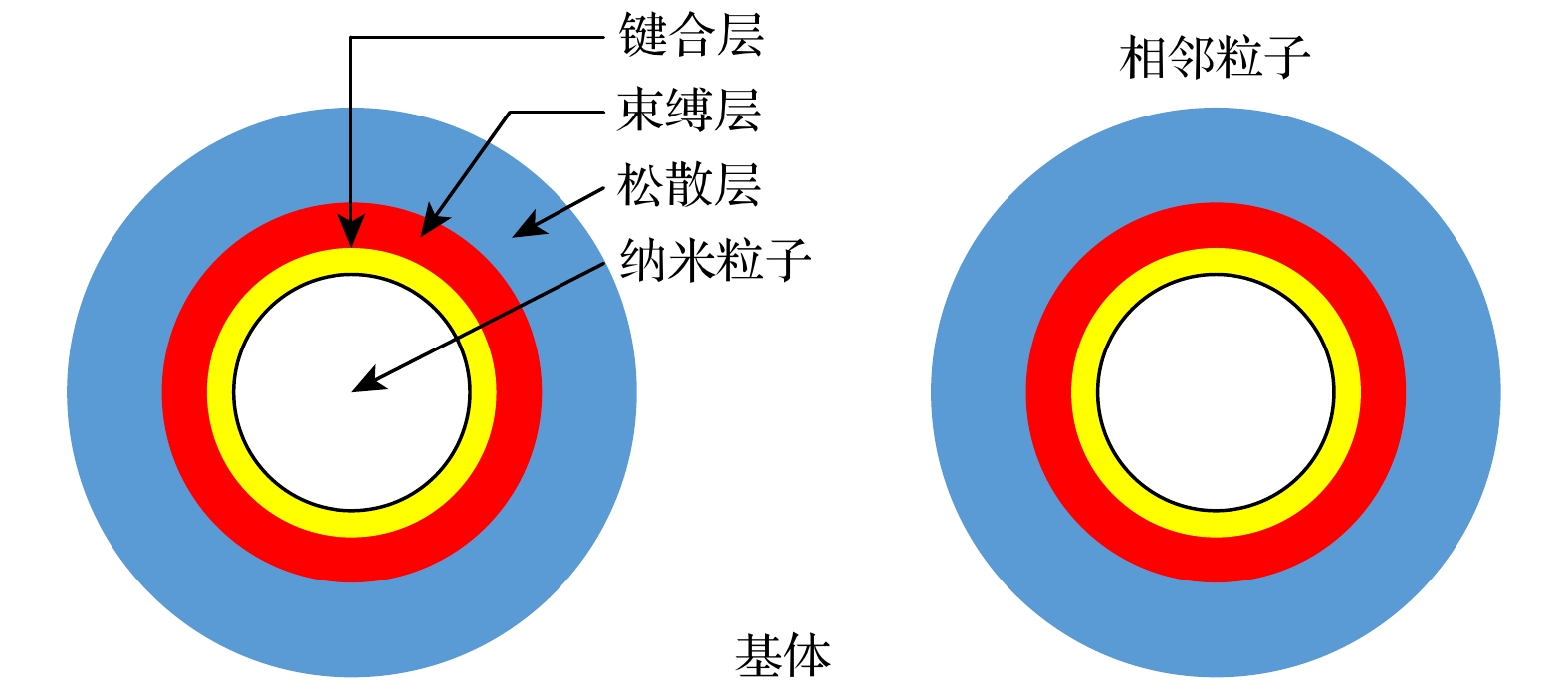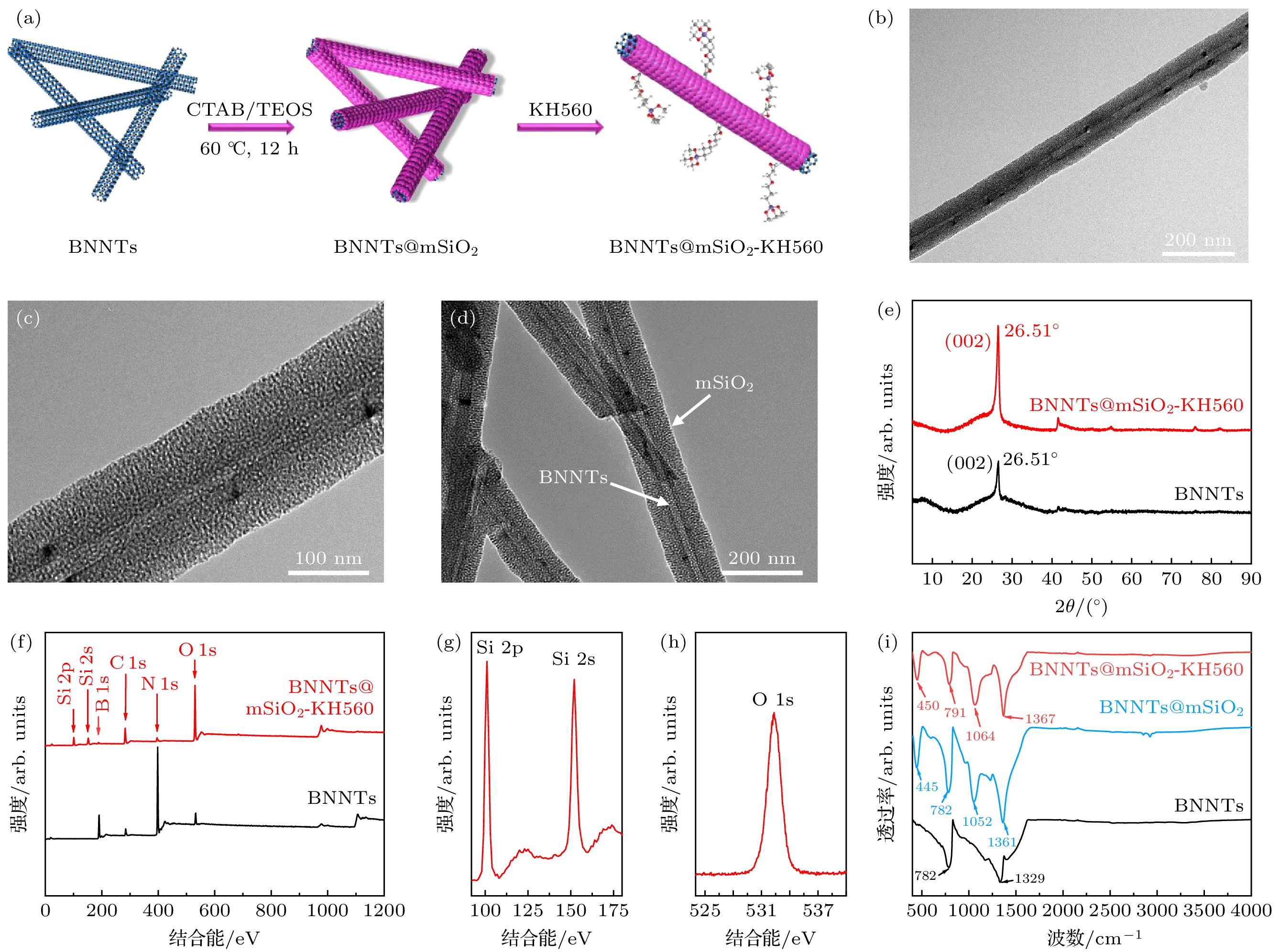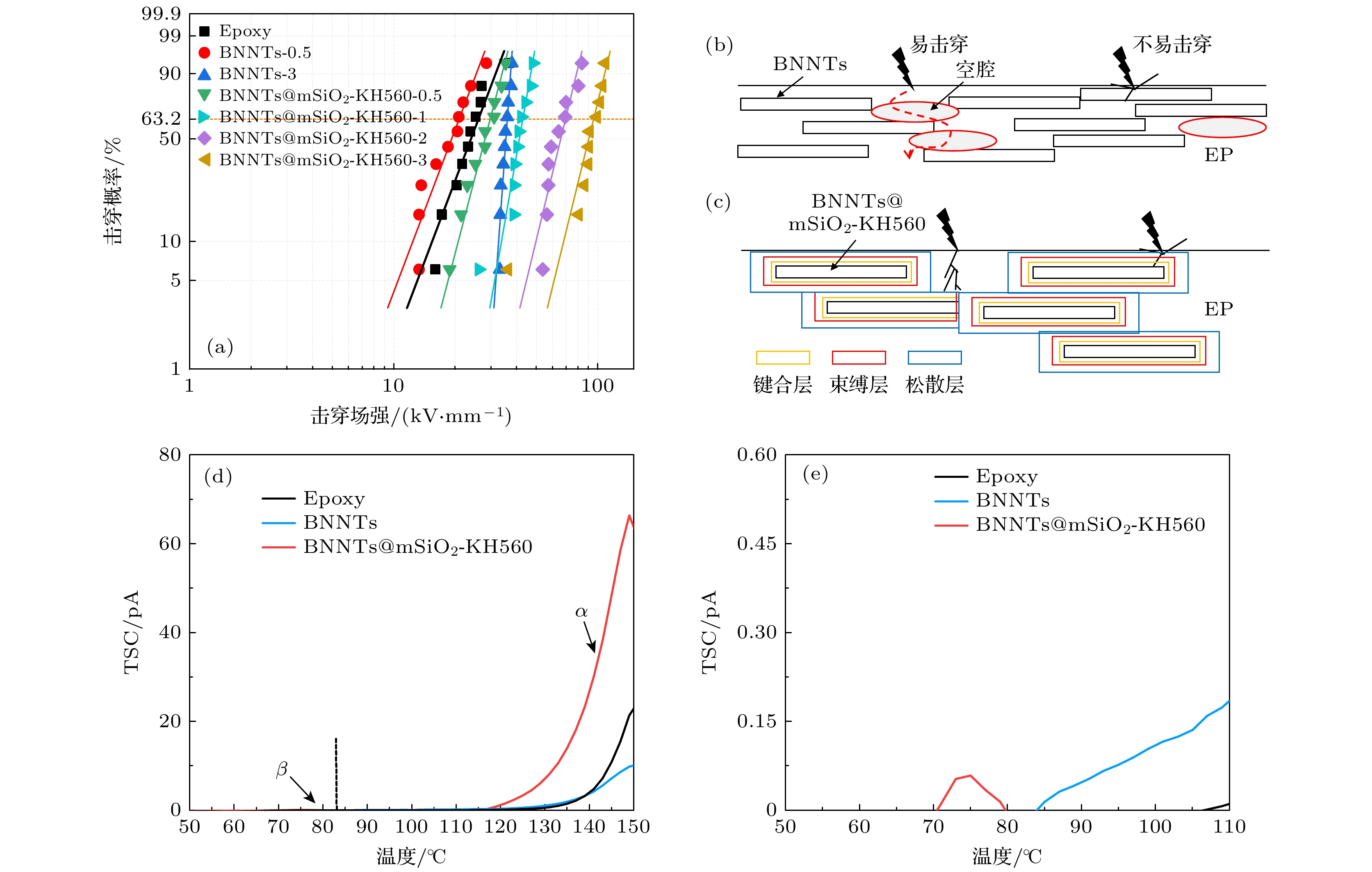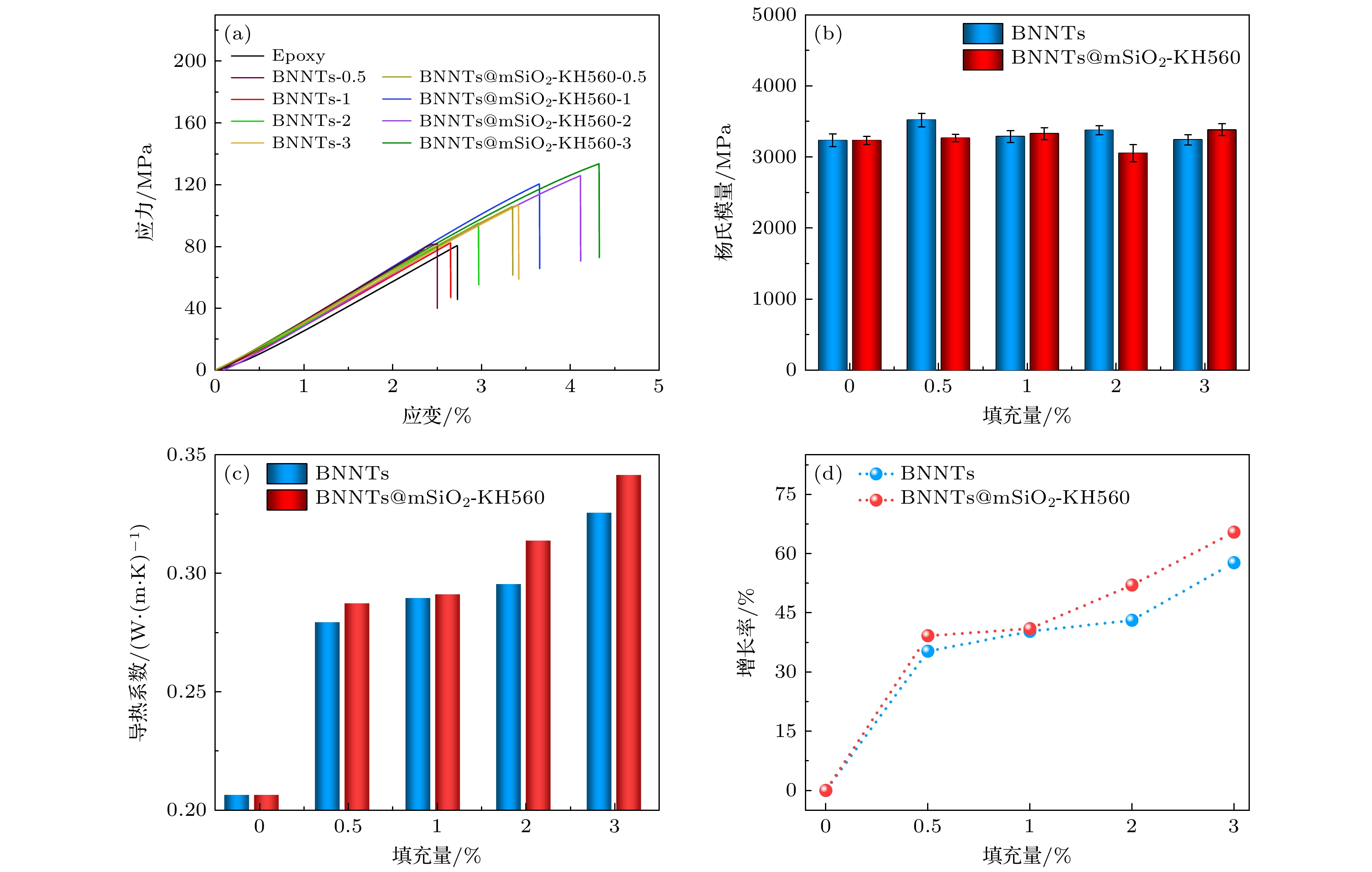-
向环氧树脂基体中加入纳米填料是实现其多功能化的常用手段, 其中拥有一维纳米结构的氮化硼纳米管 (BNNTs), 因具有超高导热系数、宽能级带隙、高长径比、高力学强度而备受关注. 然而, 表面惰性、易团聚、与环氧树脂之间界面作用弱等缺点极大地制约了BNNTs进一步应用. 基于此, 本文提出采用表面包覆介孔二氧化硅 (mSiO2), 并接枝硅烷偶联剂功能分子的方法, 优化BNNTs表面特性. 结果表明, 通过表面结构设计及功能化, 可显著改善BNNTs的分散特性, 提升其与环氧树脂的界面作用. 以此所制备的环氧复合电介质可实现力学韧性和导热系数的同步提升, 并兼具较低的介电常数与损耗. 此外, mSiO2独特的纳米介孔结构赋予复合电介质大量的深陷阱, 有效阻碍了电子的迁移, 进而提高复合电介质的电气强度. 本文为环氧树脂的多功能化提供了新思路, 亦对揭示纳米填料表面特性-复合电介质微观结构-宏观性能之间的关联关系提供了一定实验数据支撑.Adding nanofillers into epoxy resin matrices is a common method to achieve their multi-function. Boron nitride nanotubes (BNNTs) with one-dimensional nanostructures have attracted much attention because of their ultra-high thermal conductivity, wide energy level band gap, high aspect ratio and mechanical strength. Yet, the strong π-π non-covalent bonding and lip-lip interactions make BNNTs prone to agglomeration in the epoxy resin matrix. Moreover, the different physicochemical properties of BNNTs and epoxy resins as well as the chemical inertness of BNNTs surface lead to the lack of effective interfacial interaction between BNNTs and epoxy resin matrix. Therefore, the performance of the epoxy composite dielectric is not enhanced by simple blending solely, but will even have the opposite effect. To address the problems of BNNTs, in this study, the surface structure of BNNTs is constructed from the perspective of interface modulation by using sol-gel method to coat mesoporous silica (mSiO2) on BNNTs’ surface and further introducing silane coupling agent (KH560). The results indicate that the surface structure of BNNTs can optimize the level of interfacial interaction between BNNTs and epoxy resin matrix, which leads to stronger interfacial connection and elimination of internal pore phenomenon. The dielectric constant and loss of the composite dielectric prepared in this way are further reduced, reaching 4.1 and 0.005 respectively at power frequency, which is significantly lower than that of pure epoxy resin. At the same time, the mechanical toughness (3.01 MJ/m3) and thermal conductivity (0.34 W/(m⋅K)) are greatly improved compared with the counterparts of pure epoxy resin. In addition, the unique nano-mesoporous structure of mSiO2 endows the composite dielectric with a large number of deep traps, which effectively hinders the migration of electrons, thereby improving the electrical strength of the composite dielectric, and the breakdown field strength reaches 95.42 kV/mm. Furthermore, the interfacial mechanism of BNNTs’ surface structure on dielectric relaxation and trap distribution of composite dielectrics is systematically studied by Tanaka multinuclear model. The above results indicate that the good interfacial interaction between BNNTs and epoxy resin matrix is crucial in establishing the micro-interface structure and improving the macroscopic properties of composite dielectrics. This study presents a novel idea for the multifunctionalities of epoxy resin, and also provides some experimental data support for revealing the correlation among surface properties of nano-fillers, microstructure and macroscopic properties of composite dielectric.
[1] 张志斌, 任明, 宋波, 陈荣发, 余家赫, 范文杰, 董明 2022 中国电机工程学报 42 1690
 Google Scholar
Google Scholar
Zhang Z B, Ren M, Song B, Chen R F, Yu J H, Fan W J, Dong M 2022 Proc. CSEE 42 1690
 Google Scholar
Google Scholar
[2] 周远翔, 刘轩昊, 朱小倩, 卢毅, 高岩峰 2023 高电压技术 49 2891
 Google Scholar
Google Scholar
Zhou Y X, Liu X H, Zhu X Q, Lu Y, Gao Y F 2023 High Volt. Eng. 49 2891
 Google Scholar
Google Scholar
[3] Yuan S J, Peng Z Q, Rong M Z, Zhang M Q 2022 Mater. Chem. Front. 6 1137
 Google Scholar
Google Scholar
[4] Chen J, Zhou Y, Huang X Y, Yu C Y, Han D L, Wang A, Zhu Y K, Shi K M, Kang Q, Li P L, Jiang P K, Qian X S, Bao H, Li S T, Wu G N, Zhu X Y, Wang Q 2023 Nature 615 62
 Google Scholar
Google Scholar
[5] Bertasius P, Shneider M, Macutkevic J, Samulionis V, Banys J, Zak A 2019 J. Nanomater Pt. 4 5761439
 Google Scholar
Google Scholar
[6] Golberg D, Bando Y, Tang C, Zhi C 2007 Adv. Mater. 19 2413
 Google Scholar
Google Scholar
[7] Pan Z, Tao Y, Zhao Y, Fitzgerald M L, McBride J R, Zhu L, Li D 2021 Nano Lett. 21 7317
 Google Scholar
Google Scholar
[8] Zhang S, Chen W J, Zhao Y, Yang K, Du B, Ding L J, Yang W, Wu S Z 2021 Compos. B. Eng. 223 109106
 Google Scholar
Google Scholar
[9] Huang X Y, Zhi C Y, Jiang P K, Golberg D, Bando Y, Tanaka T 2013 Adv. Funct. Mater. 23 1824
 Google Scholar
Google Scholar
[10] Lewis T J 2004 IEEE Trans. Dielectr. Electr. Insul. 11 739
 Google Scholar
Google Scholar
[11] Tanaka T 2005 IEEE Trans. Dielectr. Electr. Insul. 12 914
 Google Scholar
Google Scholar
[12] Tanaka T, Kozako M, Fuse N, Ohki Y 2005 IEEE Trans. Dielectr. Electr. Insul. 12 669
 Google Scholar
Google Scholar
[13] 韩延东, 韩明勇, 杨文胜 2021 高等学校化学学报 42 965
 Google Scholar
Google Scholar
Han Y D, Han M Y, Yang W S 2021 Chem. Res. Chin. Univ. 42 965
 Google Scholar
Google Scholar
[14] 杨国清, 戚相成, 高青青, 王德意 2022 高电压技术 48 689
 Google Scholar
Google Scholar
Yang G Q, Qi X C, Gao Q Q, Wang D Y 2022 High Volt. Eng. 48 689
 Google Scholar
Google Scholar
[15] Amin M S, Molin T E, Tampubolon C, Kranbuehl D E, Schniepp H C 2020 Chem. Mater. 32 9090
 Google Scholar
Google Scholar
[16] Li B, Zeng H C 2018 ACS Appl. Mater. Interfaces 10 29435
 Google Scholar
Google Scholar
[17] 李鹏新, 崔浩喆, 邢照亮, 郭宁, 闵道敏 2022 电工技术学报 37 291
 Google Scholar
Google Scholar
Li P X, Cui H Z, Xing Z L, Guo N, Min D M 2022 Trans. CES. 37 291
 Google Scholar
Google Scholar
[18] 查俊伟, 黄文杰, 杨兴, 万宝全, 郑明胜 2023 高电压技术 49 1055
 Google Scholar
Google Scholar
Zha J W, Huang W J, Yang X, Wan B Q, Zheng M S 2023 High Volt. Eng. 49 1055
 Google Scholar
Google Scholar
[19] Zhao L H, Yan L, Wei C M, Li Q H, Huang X L, Wang Z L, Fu M L, Ren J W 2020 J. Phys. Chem. C 124 12723
 Google Scholar
Google Scholar
[20] Feng Z Q, Liu X H, Zhang W C, Zeng J J, Liu J M, Chen B F, Lin J M, Tan L Q, Liang L Y 2022 J. Mater. Sci. 57 1156
 Google Scholar
Google Scholar
[21] 高铭泽, 张沛红 2016 65 247802
 Google Scholar
Google Scholar
Gao M Z, Zhang P H 2016 Acta Phys. Sin. 65 247802
 Google Scholar
Google Scholar
[22] 邹阳, 林锦煌, 何津, 翁祖辰, 金涛 2023 电工技术学报 38 622
 Google Scholar
Google Scholar
Zhou Y, Lin J H, He J, Wen Z C, Jin T 2023 Trans. CES. 38 622
 Google Scholar
Google Scholar
[23] 张涛, 江世杰, 张宁, 任乔林, 肖洒 2022 高电压技术 48 1452
 Google Scholar
Google Scholar
Zhang T, Jiang S J, Zhang N, Ren Q L, Xiao S 2022 High Volt. Eng. 48 1452
 Google Scholar
Google Scholar
[24] Heileman K, Daoud J, Tabrizian M 2013 Biosens. Bioelectron. 49C 348
 Google Scholar
Google Scholar
[25] Achour M E, Brosseau C, Carmona F 2008 J. Appl. Phys. 103 1277
 Google Scholar
Google Scholar
[26] 成鹏飞, 王辉, 李盛涛 2013 62 057701
 Google Scholar
Google Scholar
Cheng P F, Wang H, Li S T 2013 Acta Phys. Sin. 62 057701
 Google Scholar
Google Scholar
[27] Ibragimov T D, Ramazanova I S, Yusifova U V, Rzayev R M 2023 Integr. Ferroelectr. 231 1
 Google Scholar
Google Scholar
[28] 肖异瑶, 周求宽, 宴年平, 王子悦, 武康宁, 李欢, 李建英 2017 绝缘材料 50 36
 Google Scholar
Google Scholar
Xiao Y Y, Zhou Q K, Yan N P, Wang Z Y, Wu K N, Li H, Li J Y 2017 Insul. Mater. 50 36
 Google Scholar
Google Scholar
[29] Siddabattuni S, Schuman T P, Dogan F 2011 Mater. Sci. Eng. B 176 1422
 Google Scholar
Google Scholar
[30] 张镱议, 李杭东, 郑明胜, 查俊伟, 陈松, 祝晚华, 青双桂 2022 高电压技术 48 4264
 Google Scholar
Google Scholar
Zhang Y Y, Li H D, Zheng M S, Zha J W, Chen S, Zhu W H, Qing S G 2022 High Volt. Eng. 48 4264
 Google Scholar
Google Scholar
[31] Tu Y P, Zhou F W, Cheng Y, Jiang H, Wang C, Bai F J, Lin J 2018 IEEE Trans. Dielectr. Electr. Insul. 25 1275
 Google Scholar
Google Scholar
[32] Tian F Q, Zhang L, Zhang J L, Peng X 2017 Compos. B. Eng. 114 93
 Google Scholar
Google Scholar
[33] Chen Y, Cheng Y H, Wu K, Nelson J K, Dissado L A, Li S G 2009 IEEE Trans. Plasma. Sci. 37 195
 Google Scholar
Google Scholar
[34] Yang K, Chen W J, Zhao Y S, He Y, Chen X, Du B, Yang W, Zhang S, Fu Y F 2021 ACS Appl. Mater. Interfaces 13 25850
 Google Scholar
Google Scholar
[35] 查俊伟, 肖梦雨, 万宝全, 郑明胜 2023 绝缘材料 56 1
 Google Scholar
Google Scholar
Zha J W, Xiao M Y, Wan B Q, Zheng M S 2023 Insul. Mater. 56 1
 Google Scholar
Google Scholar
[36] Zhang X D, Zhang Z T, Wang H Z, Cao B Y 2023 ACS Appl. Mater. Interfaces 15 3534
 Google Scholar
Google Scholar
[37] Tang D M, Ren C L, Wei X L, Wang M S, Liu C, Bando Y, Golberg D 2011 ACS Nano 5 7362
 Google Scholar
Google Scholar
[38] Zeng X, Sun J, Yao Y, Sun R, Xu J B, Wong C P 2017 ACS Nano 11 5167
 Google Scholar
Google Scholar
[39] Chang H B, Lu M X, Arias-Monje P J, Luo J, Park C, Kumar S 2019 ACS Appl. Nano Mater. 2 6670
 Google Scholar
Google Scholar
[40] 查俊伟, 王帆 2022 71 233601
 Google Scholar
Google Scholar
Zha J W, Wang F 2022 Acta Phys. Sin. 71 233601
 Google Scholar
Google Scholar
-
图 2 BNNTs@mSiO2-KH560纳米颗粒的制备及表征 (a) BNNTs@mSiO2-KH560纳米颗粒的制备流程; (b)—(d) BNNTs@mSiO2-KH560的TEM图像; (e) BNNTs与BNNTs@mSiO2-KH560在5°—90°的XRD图谱; (f)—(h) BNNTs与BNNTs@mSiO2-KH560的XPS图谱; (i) BNNTs与BNNTs@mSiO2-KH560的FT-IR图谱
Fig. 2. Preparation and characterization of BNNTs@mSiO2-KH560 nanoparticles: (a) Preparation process of BNNTs@mSiO2-KH560 nanoparticles; (b)–(d) TEM images of BNNTs@mSiO2-KH560; (e) XRD patterns of BNNTs and BNNTs@mSiO2-KH560 at 5°–90°; (f)–(h) XPS patterns of BNNTs and BNNTs@mSiO2-KH560; (i) FT-IR patterns of BNNTs and BNNTs@mSiO2-KH560.
图 4 复合电介质的介电性能 (a) 不同BNNTs含量的复合电介质介电常数、介质损耗因数频谱图; (b) 不同BNNTs@mSiO2-KH560含量的复合电介质介电常数、介质损耗因数频谱图
Fig. 4. Dielectric properties of composite dielectric: (a) Dielectric constant, dielectric loss spectrum of composite dielectric with different BNNTs contents; (b) dielectric constant, dielectric loss spectrum of composite dielectric with different BNNTs@mSiO2-KH560 contents.
图 7 复合电介质电击穿性能和去极化热刺激电流曲线 (a) 不同填料含量的复合电介质电击穿测试威布尔概率分布图; (b) 复合电介质电击穿通道示意图; (c) 复合电介质良好界面结合阻碍放电发展示意图; (d) 不同填料复合电介质全温谱去极化热刺激电流曲线; (e) 不同填料复合电介质β峰去极化热刺激电流曲线
Fig. 7. Electrical breakdown performance and depolarization heat stimulation current curves of composite dielectrics: (a) Weibull probability distribution diagram for electrical breakdown test of composite dielectric with different filler contents; (b) schematic diagram of composite dielectric electrical breakdown channel; (c) schematic diagram of composite dielectric possessing excellent interface combination hinders the intention of discharge emitting; (d) depolarization heat stimulation current curves with full temperature spectrum of composite dielectrics with different fillers; (e) β peak depolarization heat stimulation current curves of composite dielectrics with different fillers.
图 8 不同填料复合电介质的韧性与导热性能 (a) 不同填料复合电介质的应力-应变曲线; (b) 不同填料复合电介质的杨氏模量; (c), (d) 不同填料复合电介质的导热系数及其增长率
Fig. 8. Toughness and thermal conductivity of composite dielectric with different fillers: (a) Stress-strain curve of composite dielectric with different fillers; (b) Young’s modulus of composite dielectric with different fillers; (c), (d) thermal conductivity and its corresponding growth rate of composite dielectric with different fillers.
表 1 两项式Cole-Cole方程拟合参数表
Table 1. Table of parameters for fitting the two-term Cole-Cole equation.
复合电介质 温度/℃ $ {\omega _1} $/Hz $ {\gamma _1} $ $ {\omega _2} $/Hz $ {\gamma _2} $ $ {\varepsilon _\infty } $ $ {\varepsilon _{\text{s}}} $ Epoxy 150 0.32 0.79 8000 0.60 3.50 22.0 140 0.3 0.91 600 0.60 3.75 10.0 130 0.34 0.99 50 0.45 3.6 7.0 BNNTs 150 0.5 0.9 8000 0.60 4.60 22.0 140 0.5 0.95 5000 0.60 4.60 16.5 130 0.38 0.97 1500 0.50 4.45 10.0 BNNTs@mSiO2-KH560 150 0.25 0.9 8000 0.60 4.90 28.0 140 0.13 0.85 1000 0.45 4.50 24.0 130 0.05 0.65 260 0.45 4.30 15.0 表 2 复合电介质的标准击穿场强和形状参数
Table 2. Standard breakdown field strength and shape parameters of composite dielectric.
复合电介质 标准击穿场强/
(kV·mm–1)形状参数 Epoxy 26.02 4.31 BNNTs-0.5 20.92 4.30 BNNTs-3 36.04 22.89 BNNTs@mSiO2-KH560-0.5 29.69 6.25 BNNTs@mSiO2-KH560-1 42.90 7.35 BNNTs@mSiO2-KH560-2 69.50 6.73 BNNTs@mSiO2-KH560-3 95.42 6.67 表 3 复合电介质的陷阱深度及密度
Table 3. Trap depth and density of composite dielectric.
复合电介质 $ \alpha $ 陷阱 $ \beta $ 陷阱 $ Q $/pC $ E $/eV $ {Q_\alpha } $/pC $ E $/eV $ {Q_\beta } $/pC Epoxy 0.14 134 — — 134 BNNTs 0.07 94 — — 94 BNNTs@mSiO2-KH560 0.20 652 0.82 0.32 652.32 表 4 复合电介质的韧性
Table 4. Toughness of composite dielectric.
复合电介质 韧性/(MJ·m–3) Epoxy 1.01 BNNTs-0.5 1.02 BNNTs-1 1.04 BNNTs-2 1.37 BNNTs-3 1.83 BNNTs@mSiO2-KH560-0.5 1.78 BNNTs@mSiO2-KH560-1 2.21 BNNTs@mSiO2-KH560-2 2.61 BNNTs@mSiO2-KH560-3 3.01 -
[1] 张志斌, 任明, 宋波, 陈荣发, 余家赫, 范文杰, 董明 2022 中国电机工程学报 42 1690
 Google Scholar
Google Scholar
Zhang Z B, Ren M, Song B, Chen R F, Yu J H, Fan W J, Dong M 2022 Proc. CSEE 42 1690
 Google Scholar
Google Scholar
[2] 周远翔, 刘轩昊, 朱小倩, 卢毅, 高岩峰 2023 高电压技术 49 2891
 Google Scholar
Google Scholar
Zhou Y X, Liu X H, Zhu X Q, Lu Y, Gao Y F 2023 High Volt. Eng. 49 2891
 Google Scholar
Google Scholar
[3] Yuan S J, Peng Z Q, Rong M Z, Zhang M Q 2022 Mater. Chem. Front. 6 1137
 Google Scholar
Google Scholar
[4] Chen J, Zhou Y, Huang X Y, Yu C Y, Han D L, Wang A, Zhu Y K, Shi K M, Kang Q, Li P L, Jiang P K, Qian X S, Bao H, Li S T, Wu G N, Zhu X Y, Wang Q 2023 Nature 615 62
 Google Scholar
Google Scholar
[5] Bertasius P, Shneider M, Macutkevic J, Samulionis V, Banys J, Zak A 2019 J. Nanomater Pt. 4 5761439
 Google Scholar
Google Scholar
[6] Golberg D, Bando Y, Tang C, Zhi C 2007 Adv. Mater. 19 2413
 Google Scholar
Google Scholar
[7] Pan Z, Tao Y, Zhao Y, Fitzgerald M L, McBride J R, Zhu L, Li D 2021 Nano Lett. 21 7317
 Google Scholar
Google Scholar
[8] Zhang S, Chen W J, Zhao Y, Yang K, Du B, Ding L J, Yang W, Wu S Z 2021 Compos. B. Eng. 223 109106
 Google Scholar
Google Scholar
[9] Huang X Y, Zhi C Y, Jiang P K, Golberg D, Bando Y, Tanaka T 2013 Adv. Funct. Mater. 23 1824
 Google Scholar
Google Scholar
[10] Lewis T J 2004 IEEE Trans. Dielectr. Electr. Insul. 11 739
 Google Scholar
Google Scholar
[11] Tanaka T 2005 IEEE Trans. Dielectr. Electr. Insul. 12 914
 Google Scholar
Google Scholar
[12] Tanaka T, Kozako M, Fuse N, Ohki Y 2005 IEEE Trans. Dielectr. Electr. Insul. 12 669
 Google Scholar
Google Scholar
[13] 韩延东, 韩明勇, 杨文胜 2021 高等学校化学学报 42 965
 Google Scholar
Google Scholar
Han Y D, Han M Y, Yang W S 2021 Chem. Res. Chin. Univ. 42 965
 Google Scholar
Google Scholar
[14] 杨国清, 戚相成, 高青青, 王德意 2022 高电压技术 48 689
 Google Scholar
Google Scholar
Yang G Q, Qi X C, Gao Q Q, Wang D Y 2022 High Volt. Eng. 48 689
 Google Scholar
Google Scholar
[15] Amin M S, Molin T E, Tampubolon C, Kranbuehl D E, Schniepp H C 2020 Chem. Mater. 32 9090
 Google Scholar
Google Scholar
[16] Li B, Zeng H C 2018 ACS Appl. Mater. Interfaces 10 29435
 Google Scholar
Google Scholar
[17] 李鹏新, 崔浩喆, 邢照亮, 郭宁, 闵道敏 2022 电工技术学报 37 291
 Google Scholar
Google Scholar
Li P X, Cui H Z, Xing Z L, Guo N, Min D M 2022 Trans. CES. 37 291
 Google Scholar
Google Scholar
[18] 查俊伟, 黄文杰, 杨兴, 万宝全, 郑明胜 2023 高电压技术 49 1055
 Google Scholar
Google Scholar
Zha J W, Huang W J, Yang X, Wan B Q, Zheng M S 2023 High Volt. Eng. 49 1055
 Google Scholar
Google Scholar
[19] Zhao L H, Yan L, Wei C M, Li Q H, Huang X L, Wang Z L, Fu M L, Ren J W 2020 J. Phys. Chem. C 124 12723
 Google Scholar
Google Scholar
[20] Feng Z Q, Liu X H, Zhang W C, Zeng J J, Liu J M, Chen B F, Lin J M, Tan L Q, Liang L Y 2022 J. Mater. Sci. 57 1156
 Google Scholar
Google Scholar
[21] 高铭泽, 张沛红 2016 65 247802
 Google Scholar
Google Scholar
Gao M Z, Zhang P H 2016 Acta Phys. Sin. 65 247802
 Google Scholar
Google Scholar
[22] 邹阳, 林锦煌, 何津, 翁祖辰, 金涛 2023 电工技术学报 38 622
 Google Scholar
Google Scholar
Zhou Y, Lin J H, He J, Wen Z C, Jin T 2023 Trans. CES. 38 622
 Google Scholar
Google Scholar
[23] 张涛, 江世杰, 张宁, 任乔林, 肖洒 2022 高电压技术 48 1452
 Google Scholar
Google Scholar
Zhang T, Jiang S J, Zhang N, Ren Q L, Xiao S 2022 High Volt. Eng. 48 1452
 Google Scholar
Google Scholar
[24] Heileman K, Daoud J, Tabrizian M 2013 Biosens. Bioelectron. 49C 348
 Google Scholar
Google Scholar
[25] Achour M E, Brosseau C, Carmona F 2008 J. Appl. Phys. 103 1277
 Google Scholar
Google Scholar
[26] 成鹏飞, 王辉, 李盛涛 2013 62 057701
 Google Scholar
Google Scholar
Cheng P F, Wang H, Li S T 2013 Acta Phys. Sin. 62 057701
 Google Scholar
Google Scholar
[27] Ibragimov T D, Ramazanova I S, Yusifova U V, Rzayev R M 2023 Integr. Ferroelectr. 231 1
 Google Scholar
Google Scholar
[28] 肖异瑶, 周求宽, 宴年平, 王子悦, 武康宁, 李欢, 李建英 2017 绝缘材料 50 36
 Google Scholar
Google Scholar
Xiao Y Y, Zhou Q K, Yan N P, Wang Z Y, Wu K N, Li H, Li J Y 2017 Insul. Mater. 50 36
 Google Scholar
Google Scholar
[29] Siddabattuni S, Schuman T P, Dogan F 2011 Mater. Sci. Eng. B 176 1422
 Google Scholar
Google Scholar
[30] 张镱议, 李杭东, 郑明胜, 查俊伟, 陈松, 祝晚华, 青双桂 2022 高电压技术 48 4264
 Google Scholar
Google Scholar
Zhang Y Y, Li H D, Zheng M S, Zha J W, Chen S, Zhu W H, Qing S G 2022 High Volt. Eng. 48 4264
 Google Scholar
Google Scholar
[31] Tu Y P, Zhou F W, Cheng Y, Jiang H, Wang C, Bai F J, Lin J 2018 IEEE Trans. Dielectr. Electr. Insul. 25 1275
 Google Scholar
Google Scholar
[32] Tian F Q, Zhang L, Zhang J L, Peng X 2017 Compos. B. Eng. 114 93
 Google Scholar
Google Scholar
[33] Chen Y, Cheng Y H, Wu K, Nelson J K, Dissado L A, Li S G 2009 IEEE Trans. Plasma. Sci. 37 195
 Google Scholar
Google Scholar
[34] Yang K, Chen W J, Zhao Y S, He Y, Chen X, Du B, Yang W, Zhang S, Fu Y F 2021 ACS Appl. Mater. Interfaces 13 25850
 Google Scholar
Google Scholar
[35] 查俊伟, 肖梦雨, 万宝全, 郑明胜 2023 绝缘材料 56 1
 Google Scholar
Google Scholar
Zha J W, Xiao M Y, Wan B Q, Zheng M S 2023 Insul. Mater. 56 1
 Google Scholar
Google Scholar
[36] Zhang X D, Zhang Z T, Wang H Z, Cao B Y 2023 ACS Appl. Mater. Interfaces 15 3534
 Google Scholar
Google Scholar
[37] Tang D M, Ren C L, Wei X L, Wang M S, Liu C, Bando Y, Golberg D 2011 ACS Nano 5 7362
 Google Scholar
Google Scholar
[38] Zeng X, Sun J, Yao Y, Sun R, Xu J B, Wong C P 2017 ACS Nano 11 5167
 Google Scholar
Google Scholar
[39] Chang H B, Lu M X, Arias-Monje P J, Luo J, Park C, Kumar S 2019 ACS Appl. Nano Mater. 2 6670
 Google Scholar
Google Scholar
[40] 查俊伟, 王帆 2022 71 233601
 Google Scholar
Google Scholar
Zha J W, Wang F 2022 Acta Phys. Sin. 71 233601
 Google Scholar
Google Scholar
计量
- 文章访问数: 4397
- PDF下载量: 126
- 被引次数: 0














 下载:
下载:







